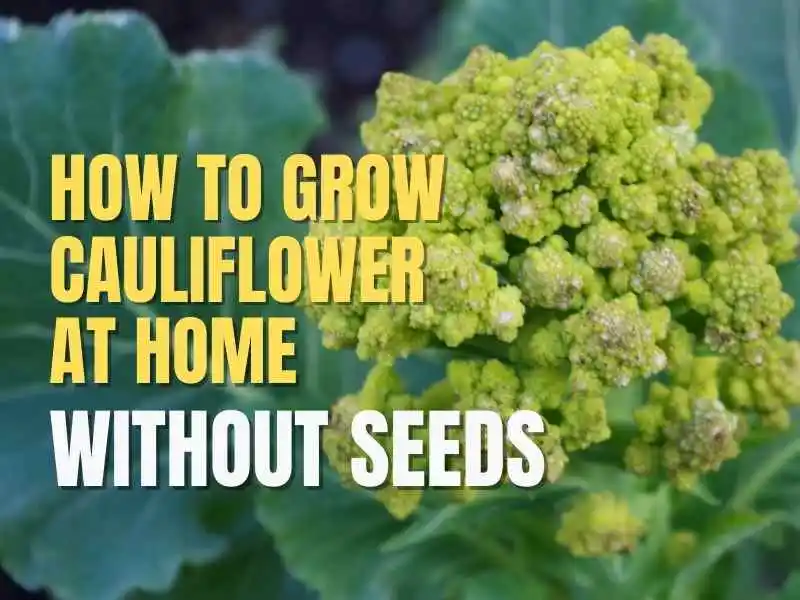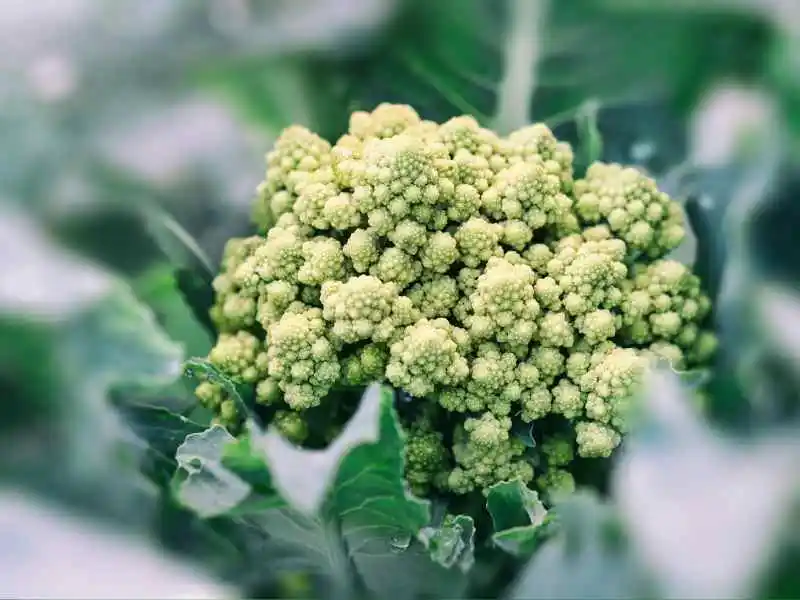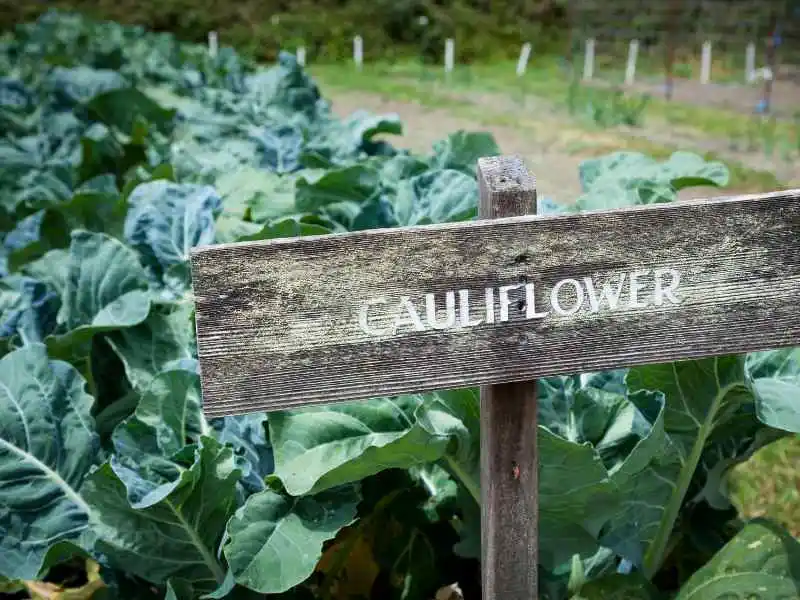Cauliflower belongs to the family of cabbage and broccoli. They all need almost similar standards to grow. Growing cauliflower is certainly a very entertaining process if you really love the richness of the harvest.

Cauliflower can be used in salads, soups, and stews or it can be consumed as a steamed vegetable. In order to grow cauliflower in your home garden, care and maintenance are important.
We shall discuss in this article, how to grow cauliflower at home without using seeds. This could be a little quicker way to start cauliflower without seeds, as you would not have to wait for the seed’s sowing and germination period.
How To Grow Cauliflower
Before diving into the ways to start this plant without seeds. We shall first look into how to grow and what are a few important steps to be taken before starting the growing process.
Few factors like when to grow, how to prepare the soil, where to place the plant, watering needs, and planting in containers or outside are common whether you grow the cauliflower plant any way you like.
These factors need to be covered in detail before continuing any further.
When to Grow Cauliflower
The cauliflower plant grows well in a cool environment. The ideal temperature to grow cauliflower would be 15 degrees Celsius or 60 degrees Fahrenheit. Its better growth completely depends upon when you grow this plant.
Every area has its own climate variables. Choose the time that fits best with the foretold temperature limit. Just remember that this plant is temperature-sensitive.
Where to Place the Cauliflower Plant

Cauliflower plants need at least 6 hours of sunlight per day. Try to choose a place that receives this much amount of sunlight. Do not put your plant in a shady place.
Keep one thing in mind your plant should not get overheated.
This would also affect the plant’s health. You can use partial shades for this purpose. Growing in containers could be very helpful in this matter.
Soil Preparation For Cauliflower
You should use nitrogen-rich and moisture-retaining soil for the best results. The soil should have complete nutrients and must provide even moisture for a longer period of time.
The soil must be potassium and nitrogen-rich. They ensure the best development of plants. Make sure that your soil must have these nutrients.
The pH level of your soil must range between 6.5 and 7. This will help reduce the risk of your plant getting diseases like clubroot.
Where To Plant
You can choose where you have to plant depending on the space you have. Whether you want to plant it in the container or outside in the garden soil, you have to keep in mind a few things.
Cauliflower plants need some space to grow. If that space is not provided, the heads will not grow properly. You should keep at least 24 inches of space reserved for one single plant.
Similarly, if you are growing the plant in a container, the container size should be large enough to provide proper room for cauliflower growth. An added benefit of growing cauliflower in containers is that you can place it anywhere you want, depending upon the light and temperature needs.
Watering the Cauliflower Plant
In order to get the best harvest, watering is the key. You need to provide consistently and even water to maintain an even moisture level. The average water requirement is 1 to one and a half inches of water per week.
Mulching the Plant
As it’s been told already that cauliflower needs moist rich soil. It’s a good practice to cover the plant soil with a layer of mulch. This could be beneficial in retaining the moisture and temperature of the soil.
Fertilizing The Cauliflower
You need to check if your plant needs any fertilizers. The common problem you can see is the turning of the cauliflower crown to brown color. In that case, the plant is facing boron deficiency. You can use borax and mix a single spoon of it with one-gallon water. Feed it to your plant once every couple of weeks. Continue this until you see significant improvements.
Slow growth could be a cause of less nutritious soil. You can test the nitrogen and potassium levels of your soil. If the soil lacks those, you have to fertilize the soil after every two weeks.
Blanching the Plant
Blanching is important for some varieties of cauliflower, although not all of them need it. In blanching, you need to cover the head of cauliflower with its own leaves and you can use some cloth pins to keep the leaves in place and cover the heads.
While blanching, keep a couple of things in mind. Firstly, make sure the leaves you are using to cover the head are not wet. If the leaves are wet they can rot the cauliflower. Secondly, they should be arranged in such a way as to allow some air to pass through the head.
If blanching is not done while growing cauliflower the whiteheads will turn yellow and it would taste bitter. While
Harvest The Cauliflower
As you have done blanching, now you can monitor the growth of cauliflower heads by removing leaves and examining the head. The ready-to-harvest head should look firm and have a size of at least 6 inches. At this stage, it is ready to be harvested.
You can now cut the head of the cauliflower from the base of the plant. Leave a few leaves at the bottom of the head. Now you can use it as your food. Wash it before using it. In order to store it, the head can be refrigerated which can keep it safe for up to a week. Alternatively, pickling the head would keep it safe for a much longer period of time.
Care For the Cauliflower Plant
Clubroot is one of the major enemies of your cauliflower. It’s a fungal disease and it destroys the plant’s growth. This is why it should be dealt with with extreme care. If you see any plant infected with this. You need to remove the entire root system of that plant and destroy to complete plant to avoid any further spread of this disease.
Another major enemy of cauliflower is blackleg. This is also a fungal disease and it is also very difficult to treat. This disease loves to attack cauliflower, cabbage, and other plants related to this family. So avoid growing these family plants frequently. Give the soil at least one to 2 years’ gap whenever you grow cauliflower or cabbage. Rotation of the crops will reduce the risk of blackleg.
Companion Plants Of Cauliflower
It is always better to use companion plants to get the best results. Beans, oregano, onions, celery, chamomile, and rosemary are a few crops that make the best companionship with the cauliflower plants.
How To Grow Cauliflower Without Seeds
Skipping the seeds sowing and germination time period. The cauliflower plant can be started in the following two ways.
- Growing cauliflower from scraps
- Growing cauliflower from transplants
How To Grow Cauliflower From Scraps

When you are growing cauliflower from scraps the results could be productive if given the proper attention and care. A Few steps are important to consider before you start the process of growing the plant from scraps.
- First of all, you have to find a healthy and good-looking cauliflower scrap. You can also use your kitchen scrap for this.
- Get the scraps removed from the head of the cauliflower. Make sure to get good-looking and healthy scraps. You should also leave some part of the head with the scraps. This will help produce good results.
- It is better to plant in containers the scrap you just got. The benefit is that it can easily be moved to any desired location.
- Water the soil thoroughly to get the best results. After preparing the soil you can now plant the scraps into the soil. The best way is to keep the scraps facing down. This will make the growth process start early.
- It’s better to start this process in a container and afterward when you see the flowers, these plants can then be moved to the garden outside.
Growing Cauliflower From Transplants or Seedlings
The second common method to start the cauliflower without using seeds is to get some healthy and good-looking plant seedlings from a well-reputed plant store in your area. Growing cauliflower from seeds is also a bit difficult process as this vegetable is very fragile.
It is better to start the production from seedlings or transplants. Once you get the seedlings you have to follow the steps given below.
- It’s better to plant the seedlings in small containers and place them indoors at the initial stage of growth.
- You can use both biodegradable and non-biodegradable containers for this step.
- Don’t place them in a dark room.
- Look for the water requirements of the plant. Don’t let the soil dry out.
- Once you see the leaves appearing on the seedlings it is time to move them outside into the garden soil.
- Before moving them into the garden, you need to follow a technique called hardening off.
- In hardening off, you gradually introduce your plant to the sunlight. Initially for one hour per day and then slowly increasing this sunlight exposure time.
- Now that the plant gets used to 4 to 5 hours of sunlight per day, you can plant it into your garden soil.
- If you have used a biodegradable container, you can bury the container in the soil.
- In the other case, you need to take the seedlings out from the container first and then dig a hole in the garden and bury the plant in it. Be careful throughout the process and don’t damage your plant.
- Make sure the soil should retain moisture as needed by the plant.
- Remember that good growth of the plant depends upon how good and even water is provided throughout the growing season.
Conclusion
The cauliflower plant is a fun activity to grow, but considering its fragility, it can give you a little hard time to deal with. It is recommended to start the plant with seedlings or transplants. As growing from seeds would be a little more difficult.
Cauliflower can also be grown from its scraps. But you may not be very much pleased with the results. As the harvested plant would not have bigger heads. But still, you can enjoy the exciting journey if you have a passion for gardening.
ALSO, READ

